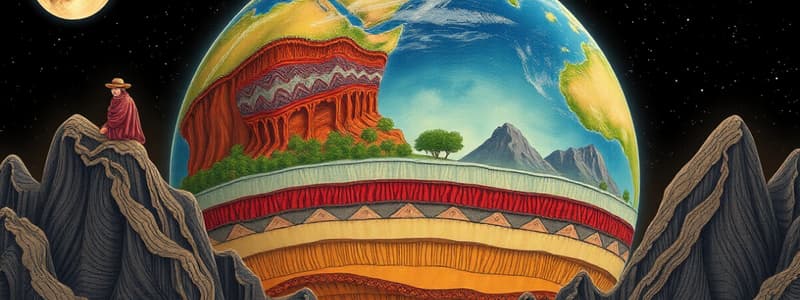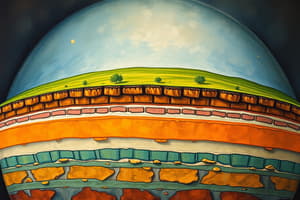Podcast
Questions and Answers
What is the primary composition of the continental crust?
What is the primary composition of the continental crust?
- Liquid metal
- Basalt
- Granite (correct)
- Iron and nickel
Which layer of the Earth is directly beneath the crust?
Which layer of the Earth is directly beneath the crust?
- Outer Core
- Inner Core
- Asthenosphere
- Mantle (correct)
What state of matter is the outer core primarily composed of?
What state of matter is the outer core primarily composed of?
- Solid rock
- Gaseous elements
- Plasma
- Liquid metal (correct)
Which part of the mantle includes the rigid layer combined with the crust?
Which part of the mantle includes the rigid layer combined with the crust?
What is the estimated temperature of the inner core?
What is the estimated temperature of the inner core?
What is the function of the Earth's magnetic field generated by the outer core?
What is the function of the Earth's magnetic field generated by the outer core?
The asthenosphere is characterized by which of the following properties?
The asthenosphere is characterized by which of the following properties?
What primarily composes the oceanic crust?
What primarily composes the oceanic crust?
What drives the movement of the mantle and tectonic plates?
What drives the movement of the mantle and tectonic plates?
What happens to areas of the mantle when they are heated by the Earth's core?
What happens to areas of the mantle when they are heated by the Earth's core?
Which phenomenon is a result of convection currents in the mantle?
Which phenomenon is a result of convection currents in the mantle?
Who proposed the theory of Continental Drift?
Who proposed the theory of Continental Drift?
What evidence did Wegener use to support his Continental Drift theory?
What evidence did Wegener use to support his Continental Drift theory?
What happens to hot material in the mantle after it rises to the surface?
What happens to hot material in the mantle after it rises to the surface?
What are convection currents in the mantle compared to?
What are convection currents in the mantle compared to?
What is one of the primary benefits of volcanic soils for agriculture?
What is one of the primary benefits of volcanic soils for agriculture?
Which form of energy can be harnessed from volcanic regions?
Which form of energy can be harnessed from volcanic regions?
What major geological features can result from the movement of tectonic plates?
What major geological features can result from the movement of tectonic plates?
What are pyroclastic flows primarily composed of?
What are pyroclastic flows primarily composed of?
Which of the following is NOT a hazard associated with volcanic eruptions?
Which of the following is NOT a hazard associated with volcanic eruptions?
What is a lahar?
What is a lahar?
How can volcanic gases impact the environment and human health?
How can volcanic gases impact the environment and human health?
Which of the following mineral resources is commonly found in volcanic areas?
Which of the following mineral resources is commonly found in volcanic areas?
What detrimental effect can ashfall have on agriculture?
What detrimental effect can ashfall have on agriculture?
What can trigger a tsunami?
What can trigger a tsunami?
What is the focus of an earthquake?
What is the focus of an earthquake?
Which scale measures the strength of an earthquake based on its effect?
Which scale measures the strength of an earthquake based on its effect?
How many times stronger is a level 6 earthquake compared to a level 5 on the Richter Scale?
How many times stronger is a level 6 earthquake compared to a level 5 on the Richter Scale?
What long-term effect can major volcanic eruptions have on the environment?
What long-term effect can major volcanic eruptions have on the environment?
What do seismologists primarily study?
What do seismologists primarily study?
What happens to structures during an earthquake of magnitude 7 or above on the Richter Scale?
What happens to structures during an earthquake of magnitude 7 or above on the Richter Scale?
What characterizes the epicenter of an earthquake?
What characterizes the epicenter of an earthquake?
What percentage of all earthquakes released by the earth each year is felt in Greece?
What percentage of all earthquakes released by the earth each year is felt in Greece?
How often does Greece experience an earthquake measuring 6 on the Richter Scale?
How often does Greece experience an earthquake measuring 6 on the Richter Scale?
What was the magnitude of Greece's most powerful earthquake recorded in 1810?
What was the magnitude of Greece's most powerful earthquake recorded in 1810?
What event caused the most fatalities in Greece, and how many people died?
What event caused the most fatalities in Greece, and how many people died?
Which part of Turkey is considered the most earthquake-prone?
Which part of Turkey is considered the most earthquake-prone?
What caused Turkey's seismicity?
What caused Turkey's seismicity?
When did Turkey experience its most severe earthquake in the twentieth century?
When did Turkey experience its most severe earthquake in the twentieth century?
How long after the 6.6 magnitude earthquake in Kozani did a 6.1 magnitude earthquake occur in Greece?
How long after the 6.6 magnitude earthquake in Kozani did a 6.1 magnitude earthquake occur in Greece?
Flashcards are hidden until you start studying
Study Notes
Earth's Interior Structure
- The Earth's interior is composed of four main layers: crust, mantle, outer core, and inner core.
- Crust: The outermost layer, relatively thin, divided into continental (thicker, less dense, mainly granite) and oceanic (thinner, denser, mainly basalt). This is where we live and most geological processes occur.
- Mantle: The thickest layer, extending to a depth of 2,900 kilometers, composed of solid rock. Divided into upper mantle (containing the lithosphere, a rigid layer including the crust and uppermost mantle) and the lower mantle. The asthenosphere, a partially molten region, lies below the lithosphere and is crucial for plate tectonics.
- Outer Core: Composed mainly of liquid iron and nickel. Its high temperature and pressure keep the liquid metal from solidifying. Movement within the outer core generates the Earth's magnetic field.
- Inner Core: The innermost layer, solid, mainly composed of iron and nickel. Despite immense pressure, it remains solid due to extremely high temperatures.
Convection Currents
- Convection currents are like heat-driven motions in a fluid where hot matter rises and cooler matter sinks.
- Inside the Earth, convection currents occur in the mantle, driven by the Earth's core heat.
- Warmer areas in the mantle become less dense and rise, carrying heat.
- As they rise and cool, they become denser and sink back down. This cyclical movement creates convection currents.
- These currents are like giant "magma rivers" moving tectonic plates, causing earthquakes, mountain formations, and volcanic activity.
Continental Drift
- Continental Drift, proposed by Alfred Wegener, suggests that the Earth's continents were once part of a supercontinent called Pangaea.
- Over time, Pangaea broke apart, and individual continents drifted to their current positions.
- Evidence for this theory includes:
- Jigsaw Puzzle Fit: The coastlines of continents fit together like pieces of a jigsaw puzzle, especially when considering the continental shelves.
- Fossil Distribution: Similar fossils found on different continents, suggesting they were once connected.
- Rock Formations: Matching rock formations and geological features found across continents.
Volcanic Areas: Benefits and Hazards
- Benefits:
- Fertile Soil: Volcanic soils are rich in minerals and nutrients, excellent for agriculture.
- Geothermal Energy: Volcanic regions have access to geothermal energy, a renewable source for electricity and heating.
- Mineral Resources: Volcanic areas contain valuable mineral deposits like sulfur, gold, silver, and other metals.
- Tourism and Recreation: Attractive volcanic landscapes and features attract tourists and outdoor enthusiasts.
- Hazards:
- Lava Flows: Destructive flows of molten rock that can move slowly or quickly, destroying infrastructure and property.
- Pyroclastic Flows: Extremely hot and fast-moving flows of gas, ash, and rocks, deadly and destructive.
- Ashfall: Large amounts of ash released into the atmosphere can disrupt air travel, damage crops, contaminate water, and pose health risks.
- Volcanic Gases: Gases released into the atmosphere can cause air pollution, acid rain, and respiratory problems.
- Lahars: Volcanic mudflows or debris flows triggered by heavy rainfall or volcanic material collapse, causing damage in valleys and river channels.
- Tsunamis: Underwater or coastal volcanic eruptions can trigger tsunamis, large waves that inundate coastal areas.
- Disruption of Infrastructure: Volcanic eruptions can damage transportation networks, power lines, and essential services.
- Long-term Environmental Changes: Large eruptions can inject ash and gases into the atmosphere, leading to temporary climate cooling and impacting weather patterns.
Formation of Earthquakes
- Major earthquakes occur at plate boundaries where the crust is subjected to enormous stress.
- The rocks bend, storing a huge amount of energy.
- This energy is released as an earthquake when the crust becomes unstable.
- The focus is the point underground where an earthquake starts, where seismic waves (shock waves) originate.
- The epicenter is the point directly above the focus on the Earth's surface, where the earthquake is felt most strongly.
- Earthquakes happen constantly, some so weak they can only be detected by seismographs.
Measuring Earthquakes
- Richter Scale: Uses numbers from 1 to 9 to measure an earthquake's strength. Each level is 10 times stronger than the previous.
- Mercalli Scale: Measures the size of an earthquake based on its impact, on a scale from 1 to 12.
- Earthquakes below 3 on either scale are only felt by seismographs.
Seismic Activity in Greece, Turkey and Italy
- Greece experiences more earthquakes than any other country in Europe, with an average of one earthquake measuring 5 on the Richter scale every 18 days.
- Greece's most powerful earthquake, measuring 7.8, occurred in 1810 in Crete.
- Turkey is mainly a seismic region, with most earthquakes being minor tremors or detectable earthquakes.
- Turkey's most severe earthquake in the 20th century occurred in Erzincan in 1939, causing an estimated 160,000 deaths.
- The Mediterranean region is prone to seismic activity due to tectonic plates converging and colliding.
- Case Study: Greece In 1995, a 6.6 magnitude earthquake struck Kozani, causing damage but no deaths. Six weeks later, a 6.1 magnitude earthquake killed 28 people in the Aegean city of Southern Greece.
Studying That Suits You
Use AI to generate personalized quizzes and flashcards to suit your learning preferences.




